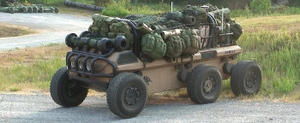In the trenchesMarines to use autonomous vehicles built by Virginia Tech students
Virginia Tech engineering students designed an unmanned ground vehicle (UGV) which the U.S. Marines Corps will test in a war game in Hawaii; the unmanned vehicles are designed to resupply troops, to reduce the actual loads manually carried by Marines, and to provide an immediate means for the evacuation of any casualties in combat

An unmanned support vehicle of the type to be tested by the Marine Corps // Source: cnet.com
Four unmanned autonomous vehicles designed and built by a team of engineering students at Virginia Tech using the TORC Robotic Building Blocks product line, are headed to Hawaii to participate in the 2010 Rim of the Pacific (RIMPAC) war games in July.
Fourteen nations, 34 ships, five submarines, more than 100 aircraft, and 20,000 personnel will participate in the biennial RIMPAC exercise which started 23 June and will go through 1 August.
The Marine Corps Warfighting Laboratory worked closely with Virginia Tech and TORC in the creation of the four Ground Unmanned Support Surrogates (GUSS) that will be used for their ability to support a platoon of U.S. Marines.
The unmanned vehicles can carry up to 1,800 pounds and can move at the speed of a troop on foot, or about five miles per hour. The vehicles are designed to resupply troops, to reduce the actual loads manually carried by Marines, and to provide an immediate means for the evacuation of any casualties in combat. A Marine unit will operate GUSS during the Naval Laboratory’s enhanced company operations experimentation that coincides with RIMPAC.
Virginia Tech and TORC, a company founded by alumni of the university’s robotics program, share a successful track record on their collaborations. Together, they developed autonomous vehicles for the Urban Challenge competition sponsored by the Defense Advanced Research Projects Agency (DARPA) in 2006 and in 2007. “The focus of the collaborations is to leverage the research capabilities of the university with the commercialization capabilities of a small business,” said Al Wicks, professor of mechanical engineering (ME) at Virginia Tech and faculty advisor to the team.
They took home third place honors in 2007 when their vehicle completed DARPA’s 60-mile course in less than six hours, with no human intervention allowed past the starting line.
The four GUSS vehicles headed to Hawaii are an outgrowth of the technology developed for these DARPA competitions, Wicks said. The sensors have been greatly improved, as well as the perception, planning, and control algorithms to navigate complex environments.
The Urban Challenge featured a cooperative environment with well-defined roads for the competition. When the GUSS vehicles are used by the Marine Corps in Hawaii, they will be “off-road and not in a cooperative environment,” Wicks said. “This is a big step forward in autonomous vehicles.”
As an example, existing algorithms developed by students under previous TORC/Virginia Tech partnerships, were used to create a customized version of the TORC AutonoNav (autonomous navigation system) product to provide the advanced off-road tactical behaviors required to meet the needs of the Marine Corps Warfighting Lab.
The rapid development and experimentation on the GUSS project was made possible through the use of TORC’s Robotic Building Blocks product line, said David Cutter, marketing manager at TORC. This enabled Virginia Tech engineers to leverage off-the-shelf technologies and focus on system integration challenges. The entire development process was completed in less than a year, with the first prototype delivered for testing in six months.
The additional three vehicles were produced in the next five months to be shipped to the RIMPAC exercises.
The WaySight, developed by TORC, is the primary operator interface for controlling the GUSS vehicles. Using the one-pound handheld unit, Marines are able to command the unmanned vehicles in several modes depending on the mission. The operator may use the WaySight to rapidly plan a new path, take remote control of the vehicle, or direct it to follow at a safe distance with the autonomous navigation system taking over.
The project is part of a five-year contract between the Naval Surface Warfare Center Dahlgren Division and Virginia Tech that is supporting a number of different projects. The contract is an on-going agreement between Dahlgren and Virginia Tech’s Institute for Critical Technology and Applied Science (ICTAS) to foster innovative research.
The engineering students who participated in the project and their hometowns are: Patrick Currier of Murfreesboro, Tennessee, Phillip Tweedy of Lynchburg, Virginia, James May of Atlanta, Georgia, Jason Doyle of Blue Ridge, Virginia, and Everett Braden of Roanoke, Virginia.
